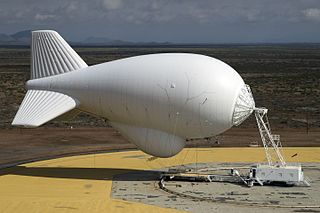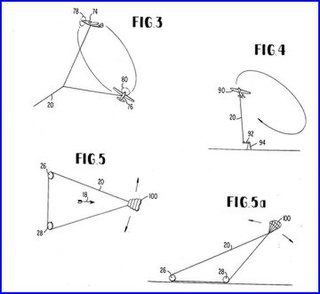
An aircraft is a vehicle that is able to fly by gaining support from the air. It counters the force of gravity by using either static lift or the dynamic lift of an airfoil, or, in a few cases, direct downward thrust from its engines. Common examples of aircraft include airplanes, helicopters, airships, gliders, paramotors, and hot air balloons.

A kite is a tethered heavier-than-air or lighter-than-air craft with wing surfaces that react against the air to create lift and drag forces. A kite consists of wings, tethers and anchors. Kites often have a bridle and tail to guide the face of the kite so the wind can lift it. Some kite designs do not need a bridle; box kites can have a single attachment point. A kite may have fixed or moving anchors that can balance the kite. The name is derived from the kite, the hovering bird of prey.

Unpowered aircraft can remain airborne for a significant period of time without onboard propulsion. They can be classified as gliders, lighter-than-air balloons and tethered kites. In the case of kites, lift is obtained by tethering to a fixed or moving object, perhaps another kite, to obtain a flow of wind over the lifting surfaces. In the case of balloons, lift is obtained through inherent buoyancy and the balloon may or may not be tethered. Free balloon flight has little directional control. Gliding aircraft include sailplanes, hang gliders, and paragliders that have full directional control in free flight.

Kite aerial photography (KAP) is a type of photography. A camera is lifted using a kite and is triggered either remotely or automatically to take aerial photographs. The camera rigs can range from the extremely simple, consisting of a trigger mechanism with a disposable camera, to complex apparatus using radio control and digital cameras. On some occasions it can be a good alternative to other forms of aerial photography.

Kiteboarding or kitesurfing is a sport that involves using wind power with a large power kite to pull a rider across a water, land, snow, sand, or other surface. It combines the aspects of paragliding, surfing, windsurfing, skateboarding, snowboarding, and wakeboarding. Kiteboarding is among the less expensive and more convenient sailing sports.

A barrage balloon is a type of airborne barrage, a large uncrewed tethered balloon used to defend ground targets against aircraft attack, by raising aloft steel cables which pose a severe risk of collision with hostile aircraft, making the attacker's approach difficult and hazardous. Early barrage balloons were often spherical. The kite balloon, having a shape and cable bridling that stabilizes the balloon and reduces drag, could be operated at higher wind speeds than a spherical balloon. Some examples carried small explosive charges that would be pulled up against the aircraft to ensure its destruction. Barrage balloons are not practical at higher altitudes due in large part to the cable's weight.
Kite types, kite mooring, and kite applications result in a variety of kite control systems. Contemporary manufacturers, kite athletes, kite pilots, scientists, and engineers are expanding the possibilities.

An aerostat or lighter-than-air aircraft is an aircraft that relies on buoyancy to maintain flight. Aerostats include the unpowered balloons and the powered airships.

An airborne wind turbine is a design concept for a wind turbine with a rotor supported in the air without a tower, thus benefiting from the higher velocity and persistence of wind at high altitudes, while avoiding the expense of tower construction, or the need for slip rings or yaw mechanism. An electrical generator may be on the ground or airborne. Challenges include safely suspending and maintaining turbines hundreds of meters off the ground in high winds and storms, transferring the harvested and/or generated power back to earth, and interference with aviation.

The Allsopp Helikite is a kite balloon or kytoon designed by Sandy Allsopp in the United Kingdom in 1993. This Helikite comprises a combination of a helium balloon and a kite to form a single, aerodynamically sound, tethered aircraft, that utilises both wind and helium for its lift.
Airborne wind energy (AWE) is the direct use or generation of wind energy by the use of aerodynamic or aerostatic lift devices. AWE technology is able to harvest high altitude winds, in contrast to wind turbines, which use a rotor mounted on a tower.

A kite balloon is a tethered balloon which is shaped to help make it stable in low and moderate winds and to increase its lift. It typically comprises a streamlined envelope with stabilising features and a harness or yoke connecting it to the main tether and a second harness connected to an observer's basket.

A tethered, moored or captiveballoon is a balloon that is restrained by one or more tethers attached to the ground so it cannot float freely. The base of the tether is wound around the drum of a winch, which may be fixed or mounted on a vehicle, and is used to raise and lower the balloon.

The Tethered Aerostat Radar System (TARS) is an American low-level airborne ground surveillance system that uses aerostats as radar platforms. Similar systems include the EL/M-2083 and JLENS.

The ram-air inflatable single-line kite is one of the few modern inventions in the world of kite design. Although Francis Rogallo's early kite patents had ram-air members in the claims, Domina Jalbert's parafoil ram-air wing, patented in 1944, emphatically changed the kite airscape for inflatable kites.

Domina Cleophas Jalbert (1904–1991) invented the ram-air inflated flexible wing, often called the "Jalbert parafoil".
Different types of flying kites have niche applications. In nature, some animals, such as spiders, also make use of kiting.

Kites are tethered flying objects which fly by using aerodynamic lift, requiring wind for generation of airflow over the lifting surfaces.
Unpowered flight is the ability to stay airborne for a period of time without using any power source. There are several types of unpowered flight. Some have been exploited by nature, others by humankind, and some by both.

Crosswind kite power is power derived from airborne wind-energy conversion systems or crosswind kite power systems (CWKPS). The kite system is characterized by energy-harvesting parts flying transversely to the direction of the ambient wind, i.e., to crosswind mode; sometimes the entire wing set and tether set are flown in crosswind mode. From toy to power-grid-feeding sizes, these systems may be used as high-altitude wind power (HAWP) devices or low-altitude wind power (LAWP) devices without having to use towers. Flexible wings or rigid wings may be used in the kite system. A tethered wing, flying in crosswind at many times wind speed, harvests wind power from an area that exceeds the wing's total area by many times.


















